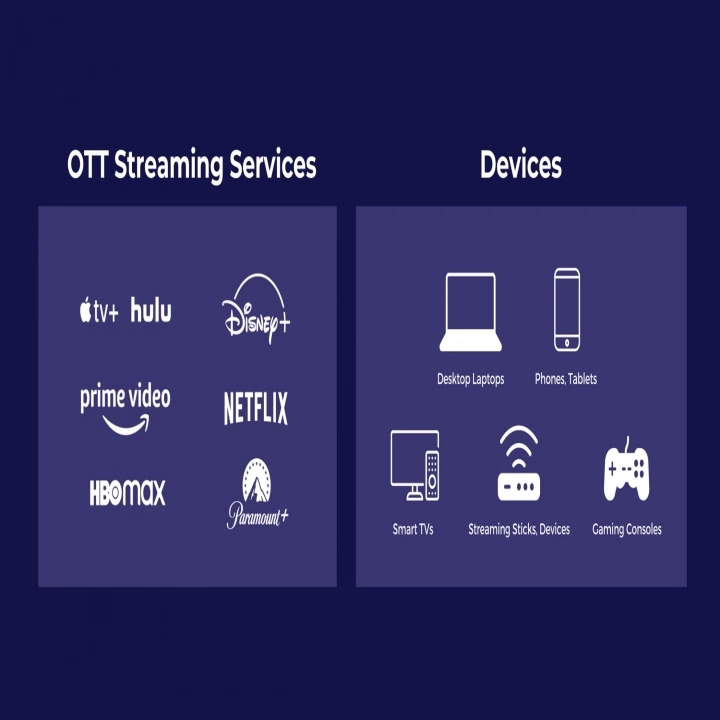CTV and OTT: Understanding Their Unique Roles in Digital Advertising

In the ever-changing digital media landscape, two giants stand out for their transformative impact on advertising: Connected TV (CTV) and Over-the-Top (OTT) platforms. As we delve into this vibrant world, it’s crucial to understand the difference between CTV and OTT and how each is redefining how brands interact with their audience.
CTV brings the internet to our living rooms, blending traditional television with the immersive online content experience. Meanwhile, OTT streams content directly over the internet, breaking free from the constraints of conventional broadcasting.
This pivotal difference between CTV and OTT paves the way for innovative advertising strategies tailored to engage viewers in a more personalized and impactful manner. As you read further, we uncover how CTV and OTT are reshaping our media consumption and rewriting the rules of digital advertising.
The Digital Advertising Landscape: From Billboards to Bytes
The advertising landscape has undergone a significant transformation. Traditional methods such as billboards, print ads, and TV commercials give way to digital strategies. This shift is driven by reaching audiences where they are most engaged — online. CTV and OTT platforms are at the forefront of this transition, offering innovative avenues for connecting with viewers.
Advertisers can use advanced algorithms and data analytics to deliver personalized ads that cater to individual viewer preferences and behaviors, enhancing viewer engagement and campaign effectiveness.
The future of advertising in the CTV and OTT space is bright and full of potential. Current trends point towards more interactive ads and the integration of AI for smarter targeting. These developments promise to make advertising more engaging and effective.
How To Choose Between OTT and CTV?
When selecting the right platform for your digital advertising campaign, choosing Over-The-Top (OTT) and Connected TV (CTV) can be pivotal. It is crucial to understand their unique strengths and how they align with your marketing objectives. Here’s a guide to help you navigate this decision:
Identifying Your Target Audience
- OTT for Broad Reach
If your diverse audience uses multiple devices — from smartphones and tablets to computers and smart TVs — OTT advertising might be your best bet. It offers the versatility to reach viewers across different digital platforms.
- CTV for Specific Targeting
In contrast, CTV advertising can be more effective if you focus on households primarily using internet-connected TVs. It targets a specific viewership that prefers large-screen experiences.
Budgeting Your Campaign
- OTT and Budget Flexibility
Advertising through OTT may require a more extensive strategy, covering various platforms, which could mean a larger budget. However, the broad reach it offers can justify the investment.
- CTV for Focused Spending
CTV advertising might be more budget-friendly if you exclusively target connected TV viewers. However, keep in mind that the cost per thousand impressions (CPM) could be higher due to the premium nature of this audience.
Enhancing User Experience
- OTT’s Diverse Ad Formats
Given that OTT content is consumed on various devices, it allows for ad formats and lengths to be flexible. However, this also means that the ad experience might vary from device to device.
- CTV’s Consistent Quality
Conversely, CTV offers a uniform, high-quality advertising experience, owing to the consistently large screen size of TVs.
Managing Ad Inventory and Fragmentation
- OTT’s Fragmented Landscape
Advertising through OTT can involve dealing with a more fragmented environment due to the myriad of devices, platforms, and apps. This requires a versatile and adaptable ad strategy.
- CTV’s More Focused Approach
CTV is less fragmented, targeting specifically internet-connected TVs. However, it’s important to tailor strategies for different TV platforms or apps.
Data and Targeting Capabilities
- Dynamic Targeting with OTT
OTT platforms can offer advanced targeting based on user behavior across various devices, especially with platforms that support dynamic ad insertion.
- Household-Level Targeting with CTV
CTV advertising can provide more focused household-level targeting, which is beneficial if your campaign targets specific demographic or geographic segments.
Measurement and Reporting Insights
- OTT’s Comprehensive View
OTT advertising provides a multi-platform perspective, offering valuable insights into how audiences interact with content across different devices.
- Focused Metrics with CTV
CTV advertising offers detailed insights into TV viewership, helping you understand how viewers engage with content on their TV screens.
How do OTT and CTV Complement Each Other?
While both methods are distinct in their delivery and reach, their collaboration opens up many opportunities for advertisers. Below, we expanded on how OTT and CTV complement each other, revolutionizing how brands engage with audiences.
The Harmony of Reach and Precision Targeting
Imagine casting a wide net with OTT to reach viewers on various devices like smartphones and desktops and then honing in on households through CTV, targeting internet-connected TVs. This combination allows advertisers to capture a broad audience while maintaining precise targeting for those enjoying their large-screen TVs.
Unified Messaging Across Screens
There’s beauty in consistency, and that’s exactly what OTT and CTV offer marketers. With OTT, your brand’s message echoes across mobiles and computers, while CTV ensures that the same message resonates in the living room. This unified approach solidifies brand messaging across different platforms.
Embracing Diverse Ad Formats
OTT platforms are versatile, allowing various ad formats tailored to different devices.
From short, snappy mobile ads to more immersive, cinematic experiences on CTV, this flexibility enables advertisers to craft device-appropriate and equally impactful messages.
Data Integration and Enhanced Analytics
OTT’s reach across devices provides a treasure trove of user behaviors and preferences data. CTV adds another layer, offering insights into TV viewership patterns. By weaving together data from both OTT and CTV, advertisers gain a comprehensive understanding of their audience, paving the way for more targeted and effective campaigns.
Amplifying Engagement Potential
The journey of a viewer often traverses multiple devices. Someone who engages with content on mobile or desktop (via OTT) may be more inclined to interact with related ads on their CTV later. This cross-device exposure significantly boosts the likelihood of engagement and brand recall.
Conclusion
As we wrap up, it’s evident that CTV and OTT platforms are at the forefront of a significant shift in digital advertising. They offer targeted, engaging, and measurable advertising experiences, departing from traditional advertising methods.
The future of advertising in these digital mediums is promising, filled with opportunities for innovation and deeper audience connections.
Read More: Fameimpact.com




